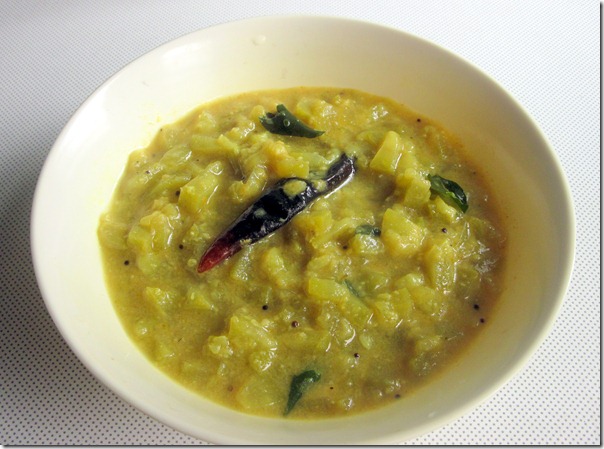I learnt this from my MIL.. We are not find of this vegetable. So i buy bottle gourd very rarely. But whenever i buy , i make only this kootu. With vathakuzhambu , it tastes divine… I've given a spicy version too. But my vote goes to the sweet version  Love it a lot..!!
Love it a lot..!!

INGREDIENTS
- Bottle gourd – 1 no (small size) or half if it is big
- Green chilly – 1 no (chopped finely)
- Salt & water – As needed
- Powdered Jaggery – 1/4 cup (adjust )
To grind - Coconut – 1/4 cup or less
- Rice flour – 1 tsp
- Water – as needed
To temper - Mustard seeds – 1/4 tsp
- Urad dal – 1/2 tsp
- Red chilly – 1 no ( full , no need to pinch)
- Curry leaves – a few
Milk (optional) at the end .. |
METHOD
- Wash and peel off the outer skin of bottle gourd .
- Cut into two halves.Now remove the center portion which has seeds.
- Finely chop it and add the green chilly pieces, salt and water.
- Pressure cook up to one whistle.Meanwhile , grind the grated coconut with rice flour adding little water or milk.
- Now open the cooker and add the powdered jaggery . Mix well. Let it boil for few minutes.Finally add the ground coconut mixture and allow it to thicken .. Add milk at the end if necessary ..
- Temper all the ingredients given above in the same order. Add to kootu ..
|
Enjoy with Vathakulambu rice and papad !!
SORAKKAI PAAL KOOTU
- Bottle gourd – 1 no (small size) or half if it is big
- Sambhar powder – 1 tsp
- Salt & water – As needed
To grind - Coconut – 1/4 cup or less
- Rice flour – 1 tsp
- Water – as needed
To temper - Mustard seeds – 1/4 tsp
- Urad dal – 1/2 tsp
- Red chilly – 1 no ( full , no need to pinch)
- Curry leaves – a few
MILK – LITTLE AT THE END |
METHOD
- Wash and peel off the outer skin of bottle gourd .
- Cut into two halves.Now remove the center portion which has seeds.
- Finely chop it and add the sambhar powder, salt and water.
- Pressure cook up to one whistle.Meanwhile , grind the grated coconut with rice flour adding little water or milk.
- Now open the cooker and add the ground coconut mixture and allow it to boil .. Add milk at the end if necessary ..
- Temper all the items given above and add to kootu..
Enjoy with rice and papad ! |

KITCHEN CLINIC
Bottle gourd
The bottlegourd belongs to the cucumber family and originated in Africa, and is now available in most parts of the world. Also known as calabash, cucuzza, sorakaya, lauki, doodhi, and ghiya in various languages, this vegetable comes in different shapes, the most common being the bottle-shaped (hence the name) and round.
The sizes vary from six inches in length to more than six feet.In the US, bottlegourds are available in farmer's markets, Asian grocery stores, as well as mainstream markets.
This is a popular vegetable in Indian cooking. When cooked, bottlegourd can be slightly sweet or bland, and lends itself to a variety of dishes.
Dried bottlegourds are used to make water bottles, bowls, musical instruments, and decorative ornaments. HEALTH BENEFITS Bottlegourd contains a lot of water - almost 96 percent is water, and as such is light and easy to digest. Bottlegourd is commonly used for treating indigestion, constipation, and diarrhea. Bottlegourd juice with a pinch of salt is also used to treat dehydration caused by diarrhea.
The water content in bottlegourd along with the high fiber content helps with constipation as well.
Low in calories (100gms has 12 calories) and low in fat, bottlegourd is a wonderful vegetable to include in any weight-loss diet.
Regular use of cooked bottlegourd is considered an effective remedy for tuberculosis, and for boosting immunity.
Bottlegourd juice mixed with sesame oil in a 50:50 ratio and applied over the scalp every night is recommended as a natural remedy for insomnia. Cooked leaves of the bottlegourd plant are also considered to be effective.
Bottlegourd has a calming influence and is effective in treating hysteria; fresh bottlegourd pulp should be applied on the forehead of the patient. Cooking Tips - Select small, tender, and firm bottlegourds (light green and fresh-looking); prick the skin, and if it's thin, it's tender. You can use tender bottlegourds with the peel and tender seeds. To use mature bottlegourd, remove the peel and seeds.
- Taste the bottlegourds before cooking, as they can sometimes be bitter.
- Wrap in plastic and refrigerate to keep the bottlegourds fresh.
- Use them for curries, soups, salads, chutneys, jams or desserts. Their neutral taste lends itself to a variety of dishes, both savory and sweet..
|



Love it a lot..!!


No comments:
Post a Comment